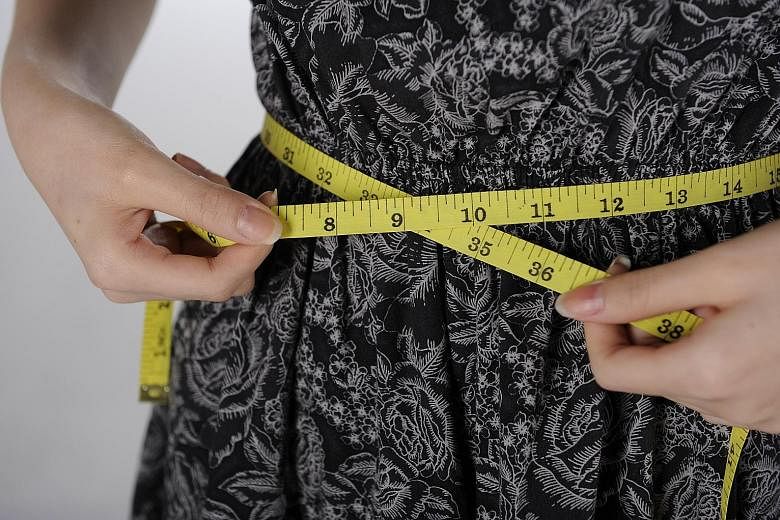Q I am a teenager who had eating issues for a few months.
I was diagnosed with anorexia in 2012.
I have recovered from it but have stopped menstruation and lost much of my thick hair.
Traditional Chinese medicine remedies have not worked.
What kind of diet should I have that would be considered healthy? And what kind of weight should I be at?
A For an average 16-year-old girl with a height of 1.58m, 41kg to 63kg is considered being of normal weight.
Body mass index (BMI) is interpreted differently for children and teenagers even though it is calculated using the same formula as that for an adult - weight in kg divided by the square of height in m.
The BMI of children and teenagers differs in gender and age, compared to adults, as the amount of body fat changes with age.
Therefore, the BMI levels in children and teenagers need to be expressed relative to other children of the same gender and age.
Once the BMI is calculated, it is plotted on a BMI-for-age percentile chart which is gender-specific.
The different percentiles then indicate various weight status categories.
Those above the 97th percentile are severely overweight; those in the 90th to 97th percentile are overweight; the fifth to 90th percentile are of acceptable weight; third to fifth percentile are underweight; and those below the third percentile are severely underweight.
On the other hand, BMI for adults is interpreted as weight status categories that are not dependent on gender or age.
According to the Health Promotion Board (HPB), the healthy BMI range for 16-year-old girls is 16.2 to 25.4.
The HPB's "My Healthy Plate" can be used to guide a teenager's meals and snacks. No one food can provide all the nutrients teenagers need, therefore make sure you consume a variety of food from the different food groups such as brown rice and wholemeal bread, fruit and vegetables, and meat and other alternatives.
Choose healthier oils and remember that food high in sugar and salt should be eaten in moderation.
The daily calorie requirements depend on the weight, height, gender and amount of physical activity of the individual.
A teenager needs about 1,600 calories per day, including essential vitamins and minerals to promote growth and development.
Some of the essential vitamins and minerals are:
•Biotin: Found in foods such as egg yolk, liver, breads and cereals.
•Niacin (B3): Found in breads and cereals, beetroot, beef liver, salmon, tuna, sunflower seeds and peanuts.
•Vitamin C: Found in citrus fruits, tomatoes and tomato juice. Potatoes are also major contributors of vitamin C to the diet. Other good sources of vitamin C include red and green peppers, kiwi fruit, broccoli, strawberries and rock melon. The vitamin C content of food may be reduced by prolonged storage and by cooking because ascorbic acid is water-soluble and is destroyed by heat. Choose cooking methods like steaming or microwaving to reduce loss of vitamin C due to cooking.
•Zinc: Although oysters contain more zinc per serving than any other food, red meat and poultry provide the majority of zinc in the diet. Other good food sources of zinc include beans, nuts, certain types of seafood such as crab and lobster, whole grains, fortified breakfast cereals, and dairy products. However, phytates, which are present in wholegrain breads, cereals, legumes and other plant food, bind zinc and inhibit its absorption. Thus, the absorption of zinc from grains and plant foods is lower than that from animal foods, although many grain- and plant-based foods are still good sources of zinc.
•Iron: There are two types of iron in food: heme and non-heme iron. Heme iron is easily absorbed by the body, and it is present in meat, fish and poultry. Non-heme iron is less easily absorbed by the body and it is present in grains, dried fruits, vegetables, nuts and beans and fortified foods like ready-to-eat breakfast cereals. Vitamin C in fruits and vegetables enhances the absorption of non-heme iron, therefore it is recommended that vitamin C-rich foods such as fruits and vegetables should be included at meals, especially if the teenager is on a vegetarian diet, or is not fond of eating meat.
•Calcium: Besides the vitamins and minerals mentioned above, calcium is also an important vitamin for teenagers. The best sources are dairy foods, such as milk, yoghurt and cheese. Other sources of calcium include fish with edible bones such as ikan bilis and sardines; bean curd, broccoli, spinach, nuts such as almonds; fortified foods and drinks such as high-calcium biscuits and high-calcium soya milk respectively.
Ms Nehal Kamdar
Senior dietitian in the Nutrition and Dietetics Department at KK Women's and Children's Hospital
GOT A PROBLEM? E-mail your question to sthealth@sph.com.sg
Specify Ask The Experts as the subject and include your name, age, gender, identity card number and contact details.

